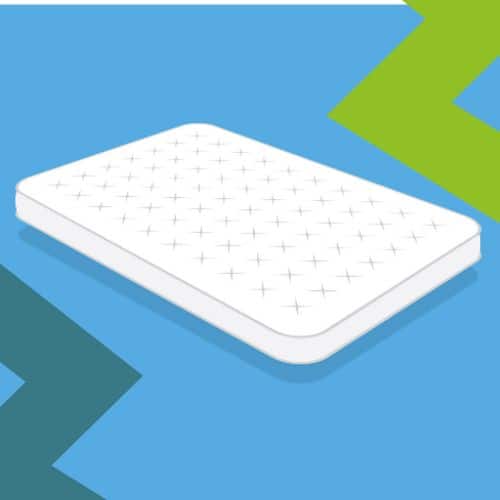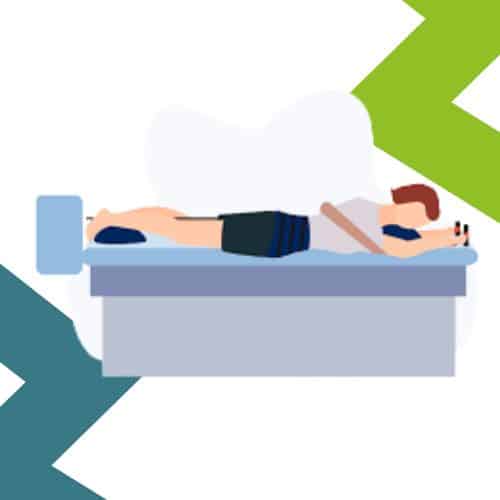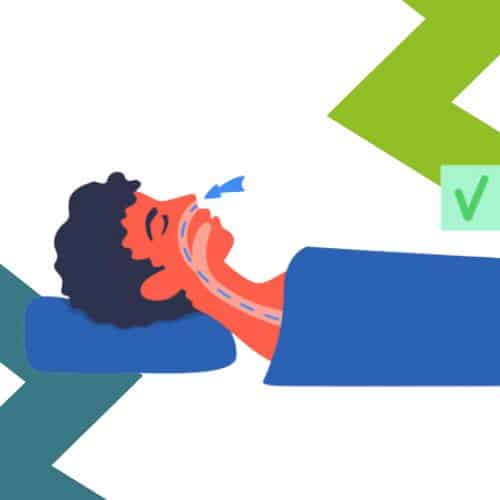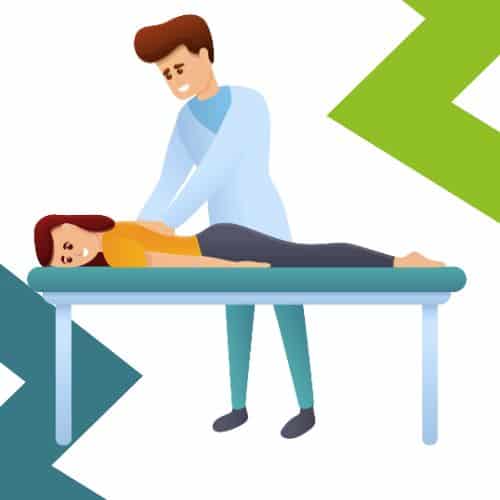Your posture may be the cause of your low back pain. According to the American Chiropractic Association, sleeping on your back places approximately 50 pounds of pressure on your spine. Although prolonged desk work or twisting while lifting heavy objects could be the cause, you’re bedding and sleeping position could also be to blame.
One of the techniques to resolve spinal issues while sleeping is spinal decompression. For this purpose, you can find a chiropractor who performs spinal decompression, or you can try these steps at home.

What to do to decompress your spine while sleeping
Prolonged hours of sitting, sleeping in the incorrect position, or sleeping on a soft mattress can compress the vertebrae in your spine. Fortunately, you can try the following techniques to eliminate back discomfort by stretching your back as you sleep.
1. Buy A Good Mattress

Purchase a mattress that provides appropriate back support. Chiropractors recommend a medium-firm mattress. If your mattress is excessively soft, you can provide additional support by adding a thick layer of plywood underneath.
Additionally, if you have a box spring, place the plywood between the box spring and the mattress. Naturally, sleeping on a hard surface will extend the spine.
2. Buy A Good Pillow
When selecting a pillow, you have a variety of options:

You may require an orthopedic pillow, often known as a cervical pillow, that provides additional neck support.
They may be initially unpleasant, but they keep the neck aligned with the spine and are better in the long run.
For example, Buckwheat pillows have existed for decades. They are natural and hypoallergenic and provide much-needed nighttime support.
Moreover, Doctors offer anecdotal data indicating that they are beneficial for patients with severe disc degeneration, osteoarthritis, and spinal stenosis.
However, personal preference also plays a role, since you may like memory foam, down, or polyester.
The ideal sleeping positions are:
Side sleepers: Lie on your side, flex your hips 30 degrees, bend your knees 30 degrees, flex to 30 degrees, and position the cushion of your choice under your neck. You might also place a tiny pillow between your knees to maintain the alignment of your hips.
On the other hand, Back sleepers should place a cushion beneath their knees at a 30-degree angle to support their lower back and decompress the spine. Your pillow should support your neck and maintain a neutral position for your head.
If you sleep on your back, get a pillow composed of memory foam or down to support and mold to the curve of your head. If you sleep on your side, you may prefer an indented foam pillow to support your neck and head.
3. Pelvic Tilts

While pillow positioning and a good mattress play an important part in spinal decompression while sleeping, the other things that matter are, the exercises. One such exercise is pelvic tilts. Incorporating pelvic tilts into workout regimens before sleeping is a great approach to relaxing the lower back.
It is simple to perform yet packs a powerful punch by stretching and strengthening the core muscles. When our core is strong, it provides the body with a great deal of support, minimizing postural abnormalities and instability that can lead to pain, or even worse, injury!
For any pregnant women among our readers, you’ll be glad to know that research indicates it is also a good method for relieving low back pain[1].
However, depending on the stage of your pregnancy, you may need to modify the activity, therefore it is advised to consult your physician first.
4. Non-surgical decompression therapy

There is nothing more excruciating than neck discomfort, yet neck/cervical traction may be an effective treatment choice for you. This procedure separates the head from the neck in order to induce expansion and facilitate decompression.
A gentle neck stretch relieves pressure on the spine by separating the vertebrae. Cervical traction is typically used as part of physical therapy treatment, or it can be performed at home with particular equipment; however, a prescription may be required in some cases.
In the first case, you should consult with a physical therapist or medical expert to determine the best course of action. If you decide to use a cervical traction device at home, they can show you how to use it correctly.
A meta-analysis indicated that cervical traction is highly effective, as significant reductions were seen in neck pain after a session and in pain levels during follow-ups[2].
In addition to cervical traction, spinal traction is used to treat herniated discs, sciatica, pinched nerves, degenerative disc disease, and numerous other back disorders. Two types of spinal traction exist:
A physical therapist will apply manual stress to joints and muscles in order to widen the spaces between the vertebrae.
Mechanical spinal traction includes lying on a table supplied with special equipment while a physical therapist uses this instrument to relieve pressure.
Although no long-term negative effects have been observed, you may feel muscle spasms and soreness in the treated areas.
However, it is necessary to consult your doctor so he or she can assess your medical history and offer the most appropriate treatment.
This will alleviate the pressure off the spine so that you can sleep at night peacefully.
5. Breathing while Sleeping

Breathing is intertwined with posture and is something we do throughout the day that might alleviate back discomfort.
The muscles you use to breathe are linked to the 5 vertebrae between your pelvis and rib cage therefore, carefully managed breathing will alleviate tension in these muscles and assist in correcting any spinal misalignment.
There is an abundance of information indicating that healthy breathing patterns can lessen or even eliminate back discomfort. For example, the Journal of Sports Rehabilitation found that a breathing program consisting of two to three sessions per week and lasting four to eight weeks helped to alleviate low back pain [3].
So, breathing exercises will also offload your spine and will help you sleep without any discomfort.
6. Stop looking down At your phone

Everyone is guilty of spending too much time on their phones, but you probably didn’t realize how much of a pain in the neck it can be.
Research reveals that Americans spend an alarming five to six hours per day on their smartphones, which does not include work-related usage [4].
No surprise so many of us get ‘text neck,’ which is characterized by tightness and mild pain in the neck and upper back.
Experts believe that a downward gaze encourages a forward head posture. For every inch the head is held forward, the weight supported by the spine increases by 10 pounds.
Consider the tremendous strain on the back of the neck as the muscles attempt to support the about 8-to-10-pound head in the extreme-forward position.
And this is not the conclusion. Experts suggest that this leads to discomfort or dysfunction in the shoulders and middle of the back by constricting the front of the neck and chest.
There are workouts that can offset the negative effects of text neck and avoid more serious problems in the future.
7. Stay Hydrated

According to the Spine Institute of North America, hydration is essential for the spine because the human back contains a remarkable quantity of water. Consequently, dehydration has detrimental effects on mobility and health.
To thoroughly comprehend the science, consider the structure of the spine:
The primary function of the spine, a column composed of discs, vertebrae, and cartilage, is to protect the spinal cord.
Discs absorb the force of our daily movement to prevent the vertebrae from grinding against one another, protecting us from severe shock and allowing us to be flexible.
If there is insufficient water in the discs, they cannot adequately cushion the bone, which can result in severe spinal issues.
As you age, it becomes increasingly vital to consume large quantities of water, as your discs become less rehydratable.
A sedentary lifestyle can make it more challenging to rehydrate the discs.
8. Chiropractor Care

More than 35 million Americans receive chiropractic care annually. Considering the health benefits, its huge popularity is not surprising.
When suffering from sciatica, neck pain, headaches, and/or low back pain, many individuals opt for spinal manipulation from a chiropractor.
A 2018 study including 750 current U.S. army members with low back pain found that individuals who received chiropractic care reported greater short-term reductions in pain intensity and pain-related impairment than those who just received medical care.
Additionally, when conducted by a certified and trained practitioner, it is relatively safe, and the side effects are mild: muscle soreness, stiffness, or a short increase in discomfort.
According to the “National Center for Complementary and Integrative Health”, spinal manipulation has been associated with extremely rare instances of major consequences, expiries, and delays in the detection of serious disorders in both children and adults.
References
- Król, A., Polak, M., Szczygieł, E., Wójcik, P., & Gleb, K. (2017). Relationship between mechanical factors and pelvic tilt in adults with and without low back pain. Journal of back and musculoskeletal rehabilitation, 30(4), 699-705.
- Yang, Jheng-Dao MD∗; Tam, Ka-Wai MD, MSc†,‡,§; Huang, Tsai-Wei RN, PhD¶; Huang, Shih-Wei MD∗,||; Liou, Tsan-Hon MD, PhD∗,||,∗∗; Chen, Hung-Chou MD∗,§,||. Intermittent Cervical Traction for Treating Neck Pain: A Meta-analysis of Randomized Controlled Trials. SPINE: July 1, 2017 – Volume 42 – Issue 13 – p 959-965 doi: 10.1097/BRS.0000000000001948
- Anderson BE, Bliven KCH. The Use of Breathing Exercises in the Treatment of Chronic, Nonspecific Low Back Pain. J Sport Rehabil. 2017 Sep;26(5):452-458. doi: 10.1123/jsr.2015-0199. Epub 2016 Aug 24. PMID: 27632818.
- https://www.statista.com/statistics/1224510/time-spent-per-day-on-smartphone-us/
Related Articles:
- How to Burn Fat While Sleeping
- How to Lose Weight While Sleeping
- How to Stop Snoring While Sleeping
- How to Relieve Hip Pain While Sleeping
- How to Prevent Dry Mouth While Sleeping
- What Causes Leg Cramps While Sleeping
- How to Clear a Stuffy Nose While Sleeping
- How to Increase Oxygen Levels While Sleeping
- How to Relieve Lower Back Pain While Sleeping
- How Many Calories Do You Burn While Sleeping
- What Should Your Heart Rate be While Sleeping
- What Causes Headaches at Night While Sleeping
- What Causes Extremely Dry Mouth While Sleeping
- How to Improve Circulation in Legs While Sleeping
- How to Relieve Back Pain During Pregnancy While Sleeping
